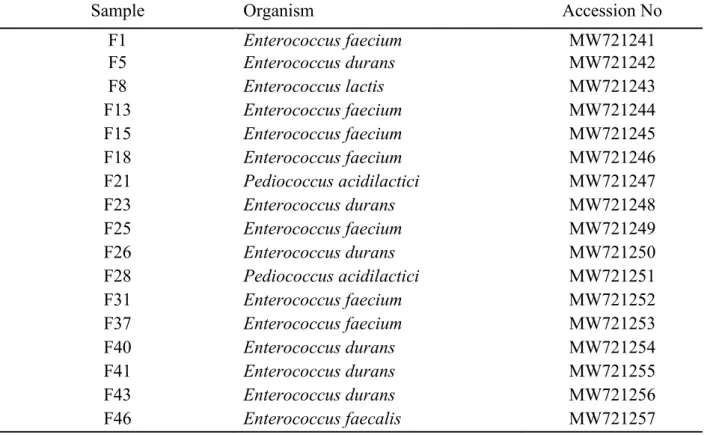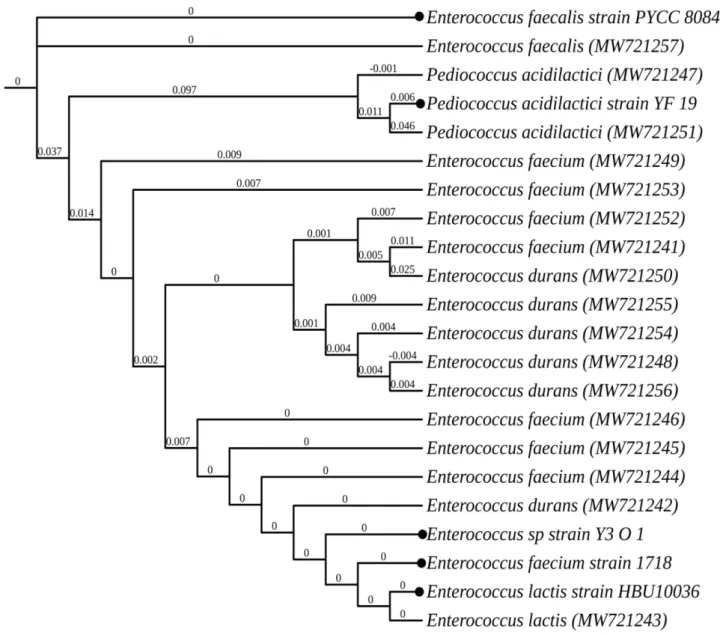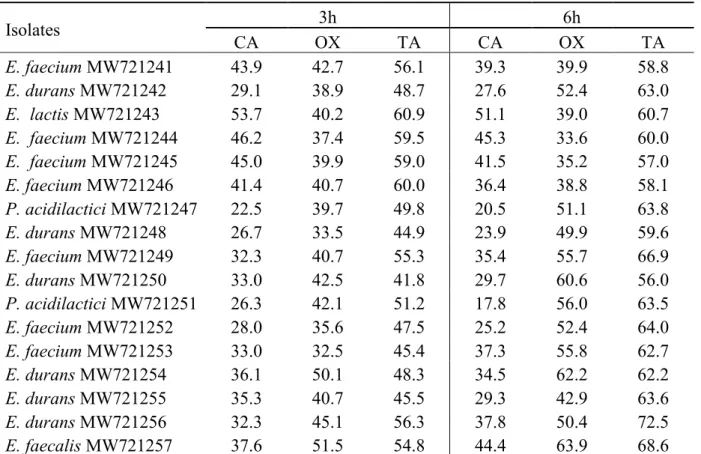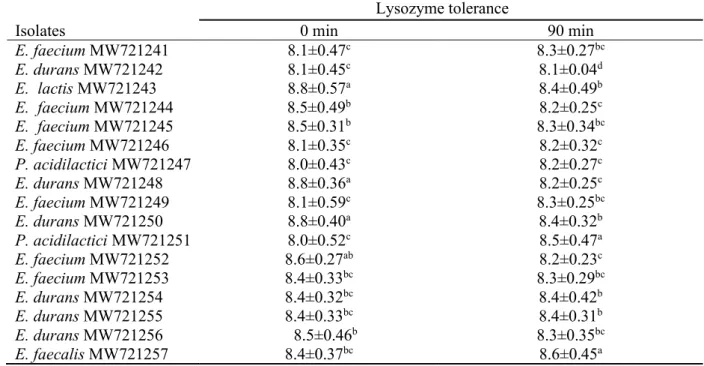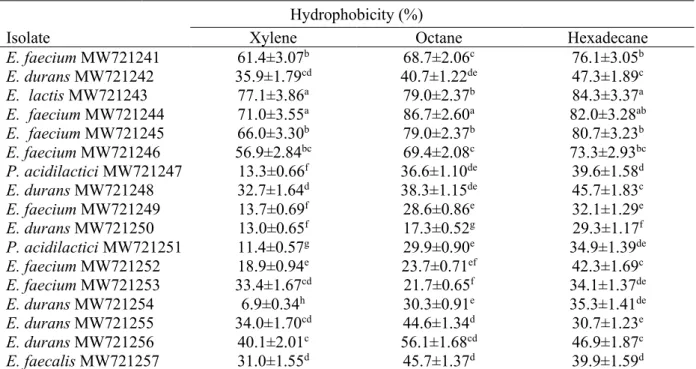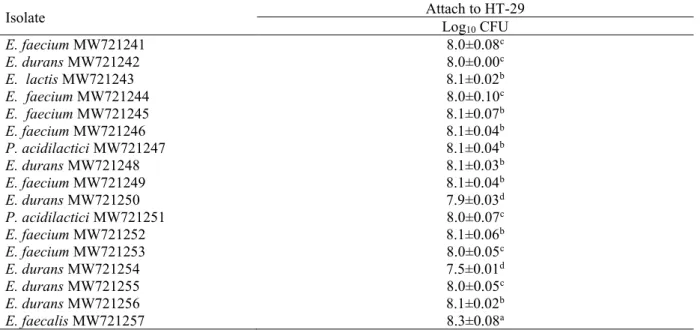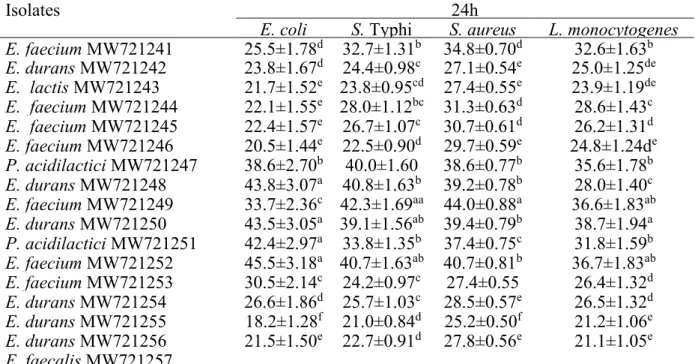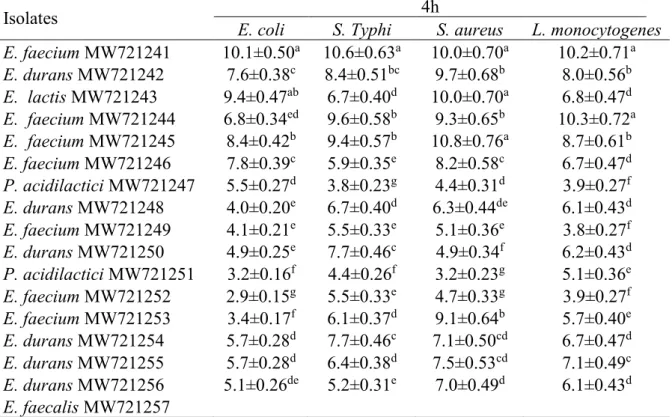This thesis has been submitted as partial fulfillment of the requirements for the master's degree in food science. Cover: Lactic acid bacteria isolated from fresh vegetable products: Potential probiotic and postbiotic properties, including immunomodulatory effects. Thus, the present study aimed to investigate the potential probiotic properties of some selected lactic acid bacteria (LAB) isolated from vegetable products.
Introduction
Clinical studies have demonstrated various health effects of consuming these microorganisms, such as reducing the duration and occurrence of diarrhea, alleviating the symptoms of lactose intolerance, reducing the incidence of pathogenic infection and stimulating the immune system and regulating the inflammatory response (de Vrese , 2008; Hill et al., 2014). In terms of nutritional composition, fruits and vegetables are considered very nutritious foods, as they provide high amounts of vitamins, such as vitamins C and A, minerals, especially electrolytes, and phytochemicals in special antioxidants that fight free radicals in the body. (Slavin & Lloyd, 2012). In addition, the colored pigments found in some fruits and vegetables such as flavonoids, lycopene, anthocyanin, β-carotene and glycosylates act as antioxidants that fight free radicals that can result in reducing the risk of certain diseases such as cancer, arthritis and aging.
Literature Review
- Probiotic Definition
- The History of Probiotics
- Probiotic Classification and Taxonomy
- Health Benefits of Probiotic
- Inflammatory Bowel Disease (IBD)
- Irritable Bowel Syndrome (IBS)
- Acute Diarrhea
- Allergic Diseases
- Colon Cancer
- Health Benefits of Food Products Fermented by Probiotics
- Antihypertension Property
- Cholesterol-Reduction Property
- Antioxidant Property
- Anticancer Properties
- Importance of Isolating New Probiotics
- Characterization of Probiotics
- Tolerances to the Gastrointestinal Tract (GI) Conditions
- Probiotics Cell Surface Properties
- Co-aggregation
- Antimicrobial Activity
- Antibiotic Resistance
- Hemolytic Activity
- Bile Salt Hydrolysis
- Cholesterol Removal
- Heat Tolerances
- Lysozyme Tolerances
- Exopolysaccharides (ESP) Production
- Isolating Novel Probiotics from Traditional Foods
- Vegetables Production in UAE
- Thesis Objective
Enterococcus species prefer acidic environments; Indeed, their main habitat is in the gastrointestinal (GI) tract (Zhong et al., 2017). In addition, probiotics have been reported to play an important role in reducing mucosal inflammation (McCarthyet et al., 2003). Isolated from fresh shrimp showed antimicrobial activity against several indicator strains (Ben Braiek et al., 2017).
Methodology
- Sample Collection
- Isolation of Lactic Acid Bacteria
- Tolerance to Stimulated Digestion Condition using INFOGEST2.0
- Bile Salts Tolerance
- Identification of the Probiotics
- Safety Assessment of Selected LAB Isolated
- Antibiotic Susceptibility Test
- Bile Salt Hydrolase (BSH) Activity
- Cholesterol Removal
- Auto-Aggregation
- Hydrophobicity
- Adhesion to HT-29 Cells
- Co-Aggregation
- Antimicrobial Production
- Lysozyme activity
- Exopolysaccharides (EPS) Production
- Statistical Analysis
Isolates to be classified as probiotics must survive several stresses during GIT transit, including low gastric pH, bile salts, and digestive enzymes (Ayyash et al., 2021). Antibiotic resistance test was performed according to Shivangi et al. 2018) with slight modifications as MRS and M17 agar plates were used for the respective isolates. The ability of the isolates to remove cholesterol was tested based on the method of Shivangi et al.
The mixture was then incubated for 15 minutes at 37°C in a water bath (ESB-18; Wisd-Witeg Labortechnik) and then cooled to room temperature. The hydrophobicity of the isolates to different hydrocarbons, namely xylene, hexadecane and octane, was evaluated according to Ayyash et al. Then, the percentage of attachment was estimated according to Oh et al. (2015) using the following equation. Adhesive Power (%) = [At.
First, Bran Heart Infusion (BHI) broth was used to activate cell suspensions and each cell suspension of the four pathogens at 37℃. The absorbance was then measured at 0 hours (A0) at 600 nm, and then the mixture was incubated at 37°C for 4 hours without mixing. To begin with, selected LAB isolates and indicator pathogens were activated overnight at 37°C in MRS and BHI broth.
However, surviving cells were then counted on MRS agar incubated anaerobically at 37℃ for two days.
Results and Discussion
Tolerance to the Gastrointestinal Conditions
- Tolerance to In-Vitro Digestive Condition
- Identification by 16S DNA
- Bile Salts Tolerance
- Lysozyme Tolerance
The overall survival rate from the beginning of INFOGEST was higher than ~90% (Table 1), indicating the resistance to salivary, gastric and intestinal fluids containing different enzymes at different pH. The mechanism of resistance to GIT conditions varies by strain and species (Ayyash et al., 2021). Using the 16S rRNA, each of the 17 isolates was able to be positively identified, aligned and classified into one of five groups of lactic acid bacteria that are.
According to the results of the sequence analysis, 7 out of 17 isolates clustered together with the 16S rRNA sequences of Enterococcus faecium, 6 out of 17 isolates clustered together with the sequences of Enterococcus durans, 2 out of 17 isolates clustered together with. Bile tolerance is one of the most important properties of probiotic strains, and it should have good resistance to bile salts to survive in humans. Bile salts have a destructive role on the membrane lipids in bacterial cells (Abdalla et al., 2021).
The presence of polysaccharides in the outer cell membrane has been suggested as a possible cause of resistance to bile salts (Yerlikaya & Akbulut, 2019; Stasiak-Różańska et al., 2021; Melchior et al., 2020). In the oral cavity, probiotic bacteria undergo saliva, which contains lysozyme as well as electrolytes; therefore, tolerance to lysozyme is one of the criteria used in the selection process of probiotic bacteria. The mean initial growth of each of the isolates was 8.3 Log10 CFU/ml and after 90 minutes of incubation with lysozyme, it was 8.4 Log10 CFU/ml.
Studies suggest that the presence of peptidoglycan in probiotics may be a cause of lysozyme resistance (Ferraboschi et al., 2021).
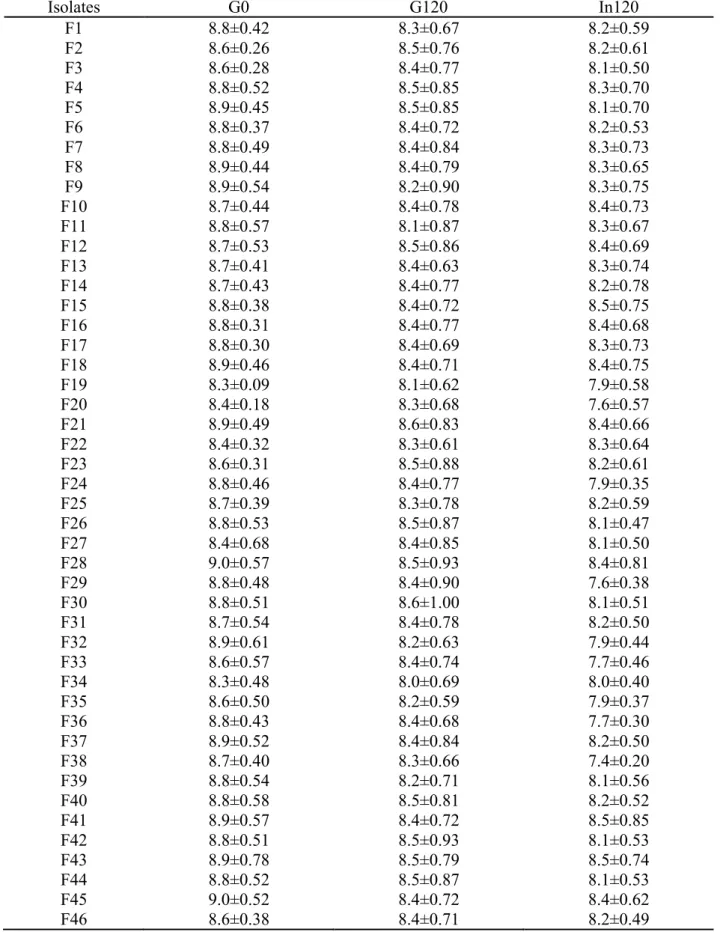
Auto-Aggregation, Co-Aggregation, Hydrophobicity, Adhesion to HT-29
- Auto Aggregation
- Hydrophobicity
- Attachment to HT-29 Cells
- Co-Aggregation
- Cholesterol Removal
The results were better than those reported in studies of isolates from dairy products, sausages and other sources (Ayyash et al., 2018b; Gao et al., 2021; Reuben et al., 2020). The interaction between lipids, peptidoglycan and surface proteins on the bacterial cell wall is involved in the adhesion. These results are consistent with those of (Oh & Jung, 2015; Vasiee, 2020; Gao, 2021), who recovered Lactobacillus, Pediococcus and Lactiplantibacillus bacteria from kimchi, alcoholic beverages and other sources, but the camel milk isolates from (Sharma et al. , 2021) showed 99% association ability, which is much better than our results.
It is thought that the ability of probiotics to adhere to epithelial cells is strain-dependent, and different cell lines have shown different attachment characteristics; therefore, the adhesion rates differ between isolates (Oh & . Jung, 2015; Domingos‐Lopes et al., 2020). This indicates that the ability to aggregate together is directly correlated with the passage of time (Abushelaibi, 2017). The results of the analysis of variance showed no significant differences in the aggregation of the four foodborne pathogens when they were found in the same isolate at the same time.
Our results show less co-aggregation than isolates obtained from colostrum and rumen water from goats, but results similar to those for probiotics obtained from sausages and dairy products. The capacity of the probiotic strains to aggregate is one of the most important factors in biofilm formation and the competition with pathogens for binding sites and is considered an essential property of probiotics. The deconjugation of bile salts by the enzyme bile salt hydrolase (BSH), the production of short-chain fatty acids, the assimilation of cholesterol into bacterial cell membranes, and the conversion of cholesterol by hydrogenation to the poorly absorbed sterol coprostanol have all been demonstrated. as mechanisms for cholesterol removal with probiotics (Hernández-Gómez et al., 2021).
From Table 9 it is seen that all the isolates have the ability to reduce the cholesterol in the broth, and the reduction percentage varied from 17% to 35%, and E.
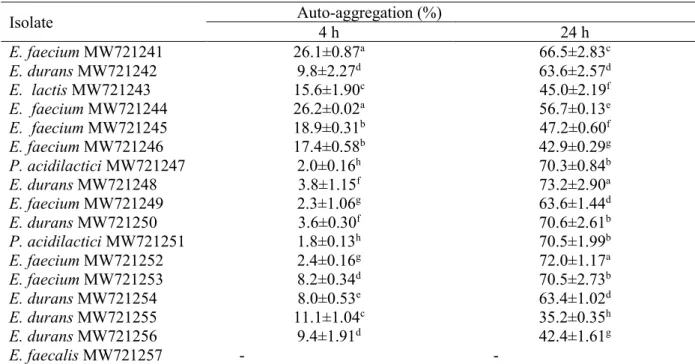
Clinical and Industrial Benefits (Bile Salt Hydrolase, Antimicrobials, and
- Bile Salt Hydrolase (BSH) Activity
- Antimicrobial Activities
- Antibiotic Resistance
- EPS Production
- Immunomodulatory Effect
One of the most remarkable effects observed is the antimicrobial activity against various pathogens. LAB isolates showed a wide range of inhibitory levels against all foodborne pathogens tested, despite a relatively broad spectrum of activity. The antimicrobial activity of the killed cells suggests that the cell membrane and cytoplasm have antimicrobial activity against foodborne pathogens.
However, the majority of probiotic bacteria were either susceptible to the majority of antibiotics or were only moderately susceptible but resistant to the vancomycin, as most of the Lactobacillus strains are known to be naturally resistant to some of the antibiotics (Wong et al. , 2015). EPS are extracellular macromolecules secreted by microorganisms either in the form of a tightly bound capsule or a loosely attached mucus layer (Angelin & Kavitha, 2020; Tarique et al., 2022). Nevertheless, EPSs have been shown to have a significant correlation with the formation of biofilms, adhesion to the intestinal cell wall, reduction in cholesterol levels and protection against harsh environmental conditions (Abdalla et al., 2021).
The literature provides a detailed description of the interaction between the gut microbiota and the immune system. Probiotics have been shown in many studies to have anti-allergic properties, mainly by inducing a predominant Th1 cytokine response (Ai et al., 2016; Vinderola et al., 2005; Cuffia et al., 2019). One of these studies claimed that probiotics can reduce the damage caused by allergic reactions to the host and identified three types of lactic acid bacteria (La, Lp and Lc) that share these characteristics (Ai et al., 2016).
Given what is already known about the propensity of BALB/c mice to develop a Th2 immune response, this is a striking finding (Mills et al., 2000).
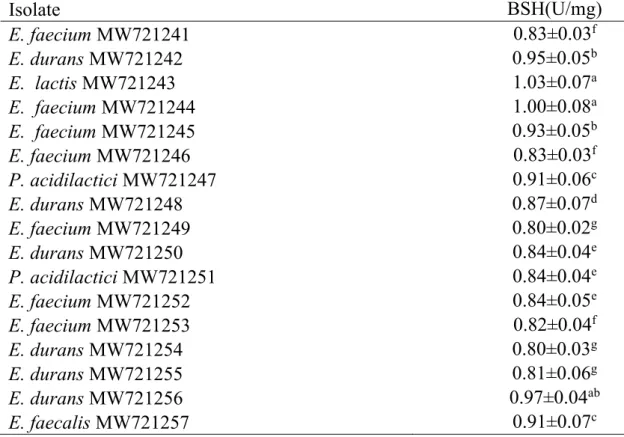
Conclusions, Limitation, and Future directions
In vitro antifungal, probiotic and antioxidant functional properties of a novel Lactobacillus paraplantarum isolated from fermented dates in Saudi Arabia. In-vitro investigation on probiotic characterization of Streptococcus and Enterococcus isolated from camel milk [Article]. Influence of growth temperature on exopolysaccharide production and probiotic properties of Lactobacillus paracasei strains isolated from kefir grains.
In vitro activity of Lactobacilli with probiotic potential isolated from cocoa fermentation against Gardnerella vaginalis. Probiotic properties and stress response of thermotolerant lactic acid bacteria isolated from cooked meat products. Isolation, characterization and evaluation of the probiotic potential of a new Lactobacillus strain isolated from feta cheese.
Potency and safety evaluation (haemolytic, cytotoxic activity) of Bifidobacterium strains isolated from raw camel milk. Potential probiotic and postbiotic properties including immunomodulatory effects of lactic acid bacteria isolated from traditional yogurt-like products. In vitro probiotic potential and safety evaluation (haemolytic, cytotoxic activity) of Bifidobacterium strains isolated from raw camel milk.
In vitro characterization of probiotic properties of Enterococcus faecium and Enterococcus durans strains isolated from raw milk and traditional dairy products. Characterization and in vitro properties of potential probiotic Bifidobacterium strains isolated from stools of breast-fed infants. Lactic acid bacteria isolated from fresh plant products: potential probiotic and postbiotic properties including immunomodulatory effects.
